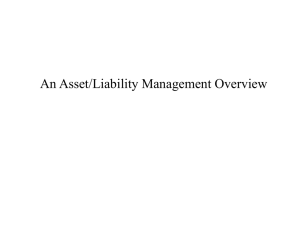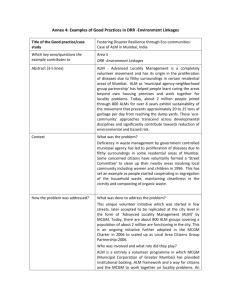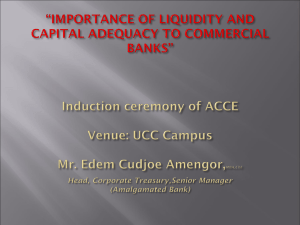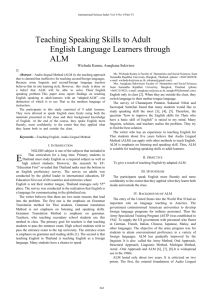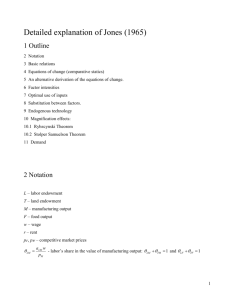AFGAP Professional training in ALM
advertisement
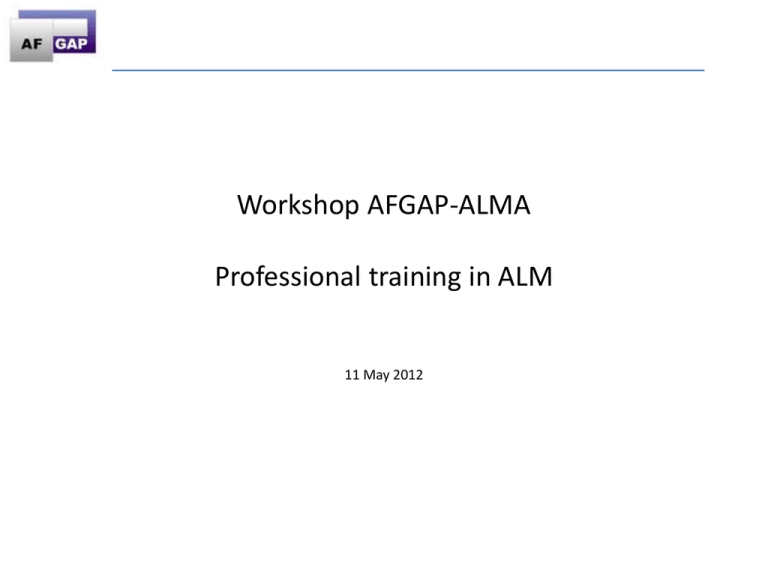
Workshop AFGAP-ALMA Professional training in ALM 11 May 2012 ALM Professional training in France As of now, only in-house ALM training programs do exist in France For example, Société Générale and BNPP have developed their in-house programs exclusively dedicated to their own employees As far as we are aware, there is no academic-based training specifically oriented toward asset-liability management Nevertheless, many academic programs on asset management, risk management, mathematical finance, actuarial sciences etc. do actually exist AFGAP has been working on a comprehensive training program in ALM under the following guidelines: mostly oriented towards banks (versus insurance companies) sponsored by AFGAP and its stakeholders anchored in one (or more) academic institution, for example ENSAE which is one of the leading graduate school in economics, finance and quantitative analysis delivering both academic and professional certification ALM Professional training in France: An example Level 1 (2-3 days) Level 2 (2-3 days) Level 3 (2-3 days) • Intoduction to banking book risks • Focus on balance-sheet / off balance sheet main exposures • Definition, economic and regulatory context, main challenges about Liquidity Risk • Modeling of maturing / non maturing products • Option modelling in ALM: interest-rate-capped loans, fixed/variable rate loans, early repayment/termination etc. • Definition, economic and regulatory context, main challenges about Interest Rate Risk • Definition, economic and regulatory context, main challenges about Currency Risk • Organisation, and risk policies • Liquidity gap, interest rate gap, risk measurement • Main risk indicators: gaps, duration analysis, interest rate margin sensitivity, present value, Earnings-at-Risk • Static liquidity gap and ongoing concern gaps gouvernance • Hedging and Funding Transfer Prices • Regulatory context: ratios, accountancy rand prudential requirements • Off-balance sheet and nonplain vanilla hedging products: swaptions • Non-linear risk modeling • Advanced hedging • Economic capital and capital management ALM Professional training in France: An example Employees targeted : • ALCO members • ALM employees in F/O and B/O departments • Risk managers • Internal auditors / Accountants • Quants • Budgeting and Capital planning executives • All employees in Finance divisions, Retail and Corporate management units etc. ALM Professional training in France: AFGAP objectives AFGAP Objectives Extending in-house program to set up a 80-hour program aimed at training any employee from AFGAP stakeholders Providing trainees with a common and unified package of skills and core competences Enhancing ALM culture in France to strengthen banks position when discussing with French and foreign regulators Developing an international english-based training program in the coming years Enrolling supervisory bodies’ and regulators’ employees in the program Connecting ALM with academic curriculum in order to develop academic research in this field Example of a training program - 4 modules 08/04/2015 1. Fundamentals of structural risks management E-learning of 80 slides. 2. Level 1 - Introduction to structural risks management 2-day training in a classroom with exercices 3. Level 2 – Advanced practice for the management of structural risks 2-day training in a classroom with exercices and a case study 4. Level 3 – Management of implicit and explicit options in ALM 2-day training in a classroom with exercices 6 I. Fundamentals of structural risks management 08/04/2015 Summary • • • • • • • Introduction. The yield curve. Intermediation activity and the ALM perimeter. The schedule and gap principles. Liquidity, interest rate and foreign exchange risks. Fund transfer pricing. ALM function regulation and organization. 7 II. Level 1 - Introduction to structural risks management 08/04/2015 Summary – 1st Part • Introduction to structural risks and their management – – – – Banking intermediation 2012 2013 2014 2015 2016 The bank balance sheet Origins and impact of structural risks Principles and tools for structural risks management 2011 2017 2018 • Liquidity risk and its management – – – – – – Origins and impact of liquidity risk Liquidity spread Illustration: the 2007-2008 and 2009-2011 financial crises Measuring liquidity risk: indicators Managing liquidity risk Regulatory guidelines regarding liquidity risk 8 II. Level 1 - Introduction to structural risks management 08/04/2015 Summary – 2nd Part • Interest rate risk and its management – Origins and impact of interest rate risk – Interest rate risk illustrations 2011 2012 2013 2014 2015 2016 – First interest rate risk measurement: the interest rate gap – Building the interest rate gap: illustrations – Second interest rate risk measurement: sensitivity. – Managing interest rate risk – Fund transfer pricing – Regulatory guidelines regarding interest rate risk • Currency risk and its management – Origins and impact of currency risk – Scope and measurement of currency risk – Managing currency risk • How risk management is organised in a bank – Regulatory guidelines and their transposition to banks – The role of ALM within a bank – The parties involved in risk management 2017 2018 9 III. Level 2 - Advanced practice for the management of structural risks 08/04/2015 Summary – 1st Part • Reminders about the basics – 2011 Reminders2012 on structural risk 2014 2013 – Reminders about the yield curve 2015 2016 2017 • Scheduling of balance sheet items – – – – – Contract Maturities and modeling principle Prepayments Non scheduled deposits and modeling principles Off Balance sheet commitments Reserve requirements – Overdrafts 10 III. Level 2 - Advanced practice for the management of structural risks 08/04/2015 Summary – 2nd Part • Indicators and hedging of structural risks – Interest rate risk 2011 2012 2013 2014 – Liquidity risk – Fund Transfer Price • External Regulation 2015 2016 2017 2018 • Special Cases: the shareholders' equity in the management of structural risks – Definitions – Group Principles on the reinvestment (re-investment) of Shareholders’ Equity Case study: preparing and conducting of the ALM Committee 11 IV. Level 3 - Management of implicit and explicit options in ALM 08/04/2015 Summary • • • • • • Part 1 - Modeling prepayments Part 2 - Modeling of home-buyer's savings plan 2011 2012 2013 2014 2015 2016 2017 Part 3 - Review of the notions of convexity, duration and sensitivity Part 4 - Pricing of a cap Part 5 - Calculation of optional ITR Part 6 - Value at Risk 2018 • Part 7 - Economic Capital required for the interest rate risk 12 08/04/2015 Illustrations 13 Banking intermediation • The fundamental role of a commercial bank is to: – Raise funds from its customers (resources); – Grant loans to various customers (uses). – Examples: deposits salaries • This is a bank's intermediation role. loans 14 The bank balance sheet ASSETS LIABILITIES CUSTOMER USES CUSTOMER RESOURCES MARKETS SHORT-TERM FINANCING Balance sheet FINANCING LONG-TERM FINANCING FIXED ASSETS SHAREHOLDERS’ EQUITY COMMITMENTS GIVEN COMMITMENTS RECEIVED MARKET TRANSACTIONS MARKET TRANSACTIONS Off-Balance sheet 15 Principles and tools for risk management • In order to guarantee that the Commercial Department receives its due share of the margin, the bank has set up the ALM Department, which matches every customer loan and every customer deposit at the market rate by going through the bank’s Treasury. 4.5% over 5 years 3% over 3 months 2% over 3 months 5% over 5 years 3% over 3 months ALM Department 4.5% over 5 years 16 Principles and tools for risk management • Transformation and anti-transformation – Two words with opposite meanings: • Transformation: short-term resources of funding matched by long-term uses • Anti-transformation: means borrowing long to lend short • The transformation margin: is the gain realised on the difference between short and long-term rates. Transformation: margin if the curve is positive 5 Anti-transformation: margin if the slope is negative 3,9 3,8 4,5 3,7 3,6 4 3,5 3,4 3,5 3,3 3,2 3 3,1 2,5 3 0 1A 2A 3A 4A 5A 6A 7A 8A 9A 10A 11A 12A 13A 14A 15A 16A 17A 18A 19A 20A 0 1A 2A 3A 4A 5A 6A 7A 8A 9A 10A 11A 12A 13A 14A 15A 16A 17A 18A 19A 20A 17 Interest rate risk hedging • Example 1: Hedging by term borrowings starting spot (if there is no swap market ) Limit = 1 A0 Interest Rate Gap - Sensitivity before hedging = -2.7 FR Interbank borrowing FR Interbank borrowing FR Interbank borrowing Interest Rate Gap after hedging A1 - 73 A2 - 67 100 100 100 - 27 33 A3 A4 A5 A6 A7 A8 A9 A10 - 56 - 45 - 45 - 28 - 7 19 - 33 - - 56 - 45 - 45 - 28 - 7 19 - 33 - Sensitivity after hedging = 0 40 Interest Rate Gap Passifs Interest Rate Gap after hedging 20 A0 A1 A2 A3 A4 A5 A6 A7 A8 A9 -20 -40 -60 A10 Sensitivity of an operation of notional 100 and of maturity : A1 1,0 A2 1,9 A3 2,7 A4 3,5 A5 4,3 A6 5,1 A7 5,8 A8 6,5 A9 7,1 A10 7,7 Actifs -80 18 Building the liquidity gap: illustrations • Example: Fixed term loan falling due in 10 years (a kind of repayment loan with constant payment intervals). Constant payment amortisation profile Y0 Y1 Y2 Y3 Y4 Y5 Y6 Y7 Y8 Y9 Y10 19 Building the liquidity gap: illustrations Liquidity risk Example: building a liquidity gap - Assets 450 Assets 400 Commitments given Fixed assets 350 Indexed rate loans FR loans 300 Securities 250 200 150 100 50 0 A1 A9 A8 A7 A6 A5 A4 A3 A2 A1 0 A0 • 20 Origins and impact of interest rate risk Market rate volatility. Inversion of the yield curve 6,00% 5,00% Flattening of the yield curve Steepening of the yield curve 4,00% 3,00% 2,00% 1,00% ar s11 no v. -1 1 m -1 0 ju il. no v. -0 9 ju in -0 8 m ar s09 10Y ju in -0 6 fé vr .- 0 7 oc t.07 05 5Y se pt .- -0 5 ja nv . ai -0 m 03 se pt .- -0 3 ja nv . 12M 4 3M 0,00% 21 Internal transfer rate • Principle of notional backing within ALM – Example with a loan customer. ALM Branch Virtual Loan same characteristics as the loan customer Client Loan to the client – Example with a client term deposit. ALM Branch Virtual Placement same characteristics as the customer deposit Client Customer deposit 22 Internal transfer rate • The internal transfer rate (ITR) intervenes in the interest margin breakdown : – Example for a loan that the Branch performs with his client: Markets Treasury Branch ALM Interes Gross Margin t Net interest income credit ALM margin Cash margin MARKETS REFUNDING RATE Client ALM REFUNDING RATE CUSTOMER RATE ITR Margin = Sales + structure + costs + Credit costs Cost of Equity ... 23 Internal transfer rate • Example 1: Indexed rate loan Commercial margin: 1.1% Liquidity: 0.4% Customer rate 3M EURIBOR + Margin : 3.5% FTP 2.4% 3M EURIBOR: 2% 24 Internal transfer rate • Example of calculation for a profile depreciable/amortizing profile? (non-linear). amount 75 ITR 1 year = 2.5% ITR 2 years = 3.55% ITR 3 years = 4.15% ITR 4 years = 4.75% ITR 5 years= 5% 1 year Width W (years) 2 years 3 years 4 years 5 years 1 2 3 4 5 Height H (amount) 17.2 16.1 14.9 13.9 12.9 Area = W H 17.2 32.2 44.7 55.6 64.5 ITR 2.5% 3.55% 4.15% 4.75% 5% ITR Area 0.43 1.14 1.86 2.64 3.22 Period Sum ( ITR Area) = 4.34% Sum ( Area) 25 Calculation of the sensitivity within SRC • ALM has tried to approach the sensitivity formula for a variation of 1%. • We can write that the value of a loan of a nominal 1 and of annual coupon C is equal (with a single discount rate) to: C 1 C 1 1 1 p n n n ( 1 r ) ( 1 r ) r ( 1 r ) p 1 n n n n (1 rnrn ) n V (C , rn ) • The change in value of the loan to an increase of 1% is written as: V V (rn , rn 1%) V (rn , rn ) V (rn , rn 1%) 1 • For a loan, we recall that if rates rise, its value decreases. • The cash flows Gap represents the trades to be set up to immunize the position. 26 Calculation of the sensitivity within ALM • If the trade to be set up is a loan and is not hedged, the entity will realize a gain if rates rise. • To characterize this gain, we will write that the change in value of the loan must be positive and will be calculated as follow : V 1 V (rn , rn 1%) 1 rn 1 1 1 rn 1% (1 rn 1%)n (1 rn 1%)n (rn 1%) (1 rn 1%)n rn (1 rn 1%)n rn (rn 1%) (rn 1%) (1 rn 1%)n (1 rn 1%)n (rn 1% rn ) 1% (rn 1%) (1 rn 1%)n (1 rn 1%)n 1 1% (rn 1%) (1 rn 1%)n 1% 1 1 rn 1% (1 rn 1%)n 27 Prepayment modelling: • Step 1 - Calculation of the outstanding loan balance • Step 2 - Calibration of the seasonality parameters by stratification • Step 3 - Calibration of the parameters of seasoning by stratification • Step 4 - Calibration of the dependence on interest rate • Step 5 - Validation : consistency & predictive power 28 Step 2 - Modeling of the seasonality Stratification : To avoid rate effect on seasonal coefficients, we sort the couples (i,t) of loan i and date t in 10 divisions that we call “strate”. Prepayment rate by division Minimization 29 Step 4 – PP Dependence on interest rates • • In theory, there is a level of interest rates at which all rational agents would have to prepay. Thus we seek a function with a “threshold effect" to illustrate the dependence of PP on interest rates. Arctangent function with rate dependent coefficients • Minimization 30 Exercice Sensitivity of the NAV The NAV of the 5-year bond paying a 4% yield is the following : Year Rate Cash Flow Df « Rate" Discounted Cash Flow Notional : 1 1,30% 4 0,987 3,9 100 2 1,60% 4 0,969 3,9 Coupon : 3 2,10% 4 0,940 3,8 4% 4 2,50% 4 0,906 3,6 5 2,80% 104 0,871 90,6 Total 105,8 Goal. Compute the NAV of the bond after an increase of the yield curve of 0.5%. Step 1. Compute the new discount factors. Year Rate Rate +0.5% Cash Flow Df « Rate+0.5%" Notional : 1 1,30% 1,80% 4 0,982 100 2 1,60% 2,10% 4 0,959 Coupon : 3 2,10% 2,60% 4 0,926 4% 4 2,50% 3,00% 4 0,888 5 2,80% 3,30% 104 0,850 Total Discounted Cash Flow

